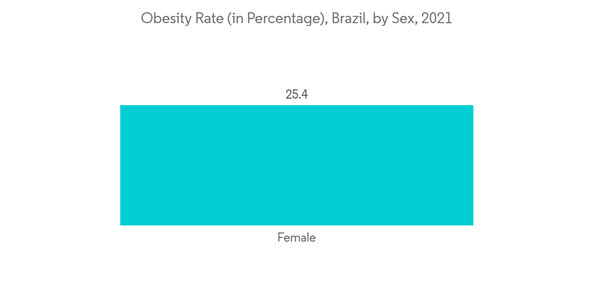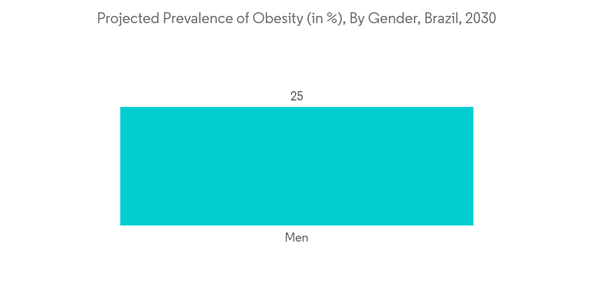The healthcare system witnessed enormous challenges as a result of the COVID-19 pandemic. All outpatient treatments were postponed or restricted during the COVID-19 pandemic to reduce the risk of viral transmission, as most chronic therapies were regarded as non-urgent. For instance, an article published in the World Neurosurgery Journal in November 2021 indicated that the neurooncological practice was one of the most affected by the pandemic due to restricted elective procedures and new triage protocols. The COVID-19 pandemic has increased costs per procedure for various neurosurgical procedures. Such factors affected the market growth during the COVID-19 pandemic. However, with the number of COVID-19 cases reducing and the decrease in the severity of the virus, the market is expected to grow significantly over the forecast period.
The Brazil spinal surgery devices market will show rapid growth due to increasing incidences of obesity and degenerative spinal conditions and technological advances in spinal surgery.
Also, there was a continuous increase in the prevalence of excess weight, overweight, and obesity in Brazil. According to an article published in the PLOS One Journal in September 2021, there was a need for raising an alert to the problem and the urgent need for initiatives aimed at controlling overweight and obesity since excess weight affected half of the Brazilian population. Therefore, the rate of obesity in Brazil is on the rise. These numbers are further expected to increase with changing lifestyles and food consumption methods in developed countries. Along with a likely increase in spinal problems in obese populations, owing to the rise in obesity, degenerative spinal conditions are also expected to increase.
Moreover, per the WHO and the Brazilian Institute of Geography and Statistics, by 2040, the senior population in Brazil (aged ≥ 60 years) will reach approximately 55 million, resulting in a high prevalence of chronic functional neurological disorders that can be treated using spinal surgery. Despite increasing hospital admissions of this population, studies on most neurological disorders among older adult inpatients are scarce, particularly in Brazil. Therefore, with the increase in the geriatric population, the number of people suffering from lower back pain and other degenerative spinal conditions, which demand spinal surgical treatment, is expected to increase during the forecast period.
However, the expensive treatment procedures associated with spinal surgery are likely to slow down the growth of the studied market over the forecast period.
Brazil Spinal Surgery Devices Market Trends
ThoracoLumbar Spinal Fusion is Expected to hold its Highest Market Share in the Device Type Segment
The thoracolumbar spinal fusion devices in the market provide conventional yet effective treatments to patients suffering from lumbar spinal stenosis and advanced alternative treatments for decompression spine surgery. The major market players manufacture anterior and posterior dynamic stabilization devices for the lumbar spine. Moreover, many clinical trials are in the process of further development. This factor is likely to offer various benefits to the market studied.The number of people affected by thoracolumbar injuries in the nation is an essential factor fuelling the segment's growth. For instance, according to an article published in SciELO in September 2021, thoracolumbar burst fractures accounted for over 45% of the significant injuries in the São Paulo region of Brazil. Thoracolumbar fractures are usually treated with percutaneous fusion since they support the reduction of operative time and blood loss, as well as less soft tissue trauma. The significant prevalence of thoracolumbar fractures in the nation, which increases the number of thoracolumbar spinal fusion surgeries performed, is expected to boost the segment's growth over the forecast period.
Also, the recent product approvals in that nation are likely to add to the market growth over the forecast period. For instance, in October 2021, SpineGuard received clearance from ANVISA (Agência Nacional de Vigilância Sanitária), the Brazil government regulatory authority, to sell its Dynamic Surgical Guidance (DSG) Connect products in Brazil. Dynamic Surgical Guidance is a radiation-free real-time sensing technology that secures and streamlines the placement of implants in the spine by helping reduce the number of thoracic and lumbar pedicle screws used in the thoracolumbar spinal fusion. Such activities are likely to add to the growth of the studied segment in the nation.
Discectomy Segment is Anticipated to Grow at a Fastest Rate Over the Forecast Period
Discectomy is the medical term for the surgical removal of a herniated disc’s damaged area in the spine. When a portion of the disc's softer interior material pushes through a tear in its harder outside, the result is a herniated disc. This may aggravate or put pressure on surrounding nerves, resulting in discomfort, numbness, or weakening. Thus, the segment is anticipated to witness growth owing to an increased incidence of herniated discs in the United Kingdom.The demand for discectomy is increasing in Brazil, creating opportunities for spine surgery devices. Cervical disc disease generally involves anterior cervical discectomy and fusion (ACDF). Following ACDF, recurrent laryngeal nerve palsy (RLNP) is a known complication. Additionally, a research article published in November 2022 in the IJSS journal mentioned that full endoscopic spine surgery (FESS) is proven for surgical correction of herniated discs and stenoses in the lumbar and cervical spine, and several shreds of evidence are there for the thoracic spine in Brazil recently. As per the source above, a discectomy was performed to treat these herniated discs, which showed a superior result.
Furthermore, it is proven that height and heavy body mass are often important contributors to the herniation of lumbar intervertebral disc. As the obese population is increasing in the country, the risk of disc hernitaion also rising. According to an article published in the Scientifc Reports Journal in July 2022, the prevalences of body mass index (BMI) categories is estimated to be 68.1% for overweight, 29.6% for obesity and 9.3% for obesity classes II and III by 2030 in Brazil. This burden of obese people in the country can further lead to discectomy or micro-discectomy procedures for treatment, fueling the segment growth in Brazil. Therefore, due to the advantages associated with discectomy and high adoption of the procedures, the segment is expected to grow over the forecast period.
Brazil Spinal Surgery Devices Market Competitor Analysis
The Brazil spinal surgery devices market is moderately competitive and consists of several major players. Moreover, with increasing technological advancements and product innovations, mid-size to smaller companies are growing their market presence by introducing new technologies with better usability.Additional benefits of purchasing the report:
- The market estimate (ME) sheet in Excel format
- 3 months of analyst support
This product will be delivered within 2 business days.
Table of Contents
Companies Mentioned (Partial List)
A selection of companies mentioned in this report includes, but is not limited to:
- Medtronic PLC
- Styker Corporation
- Johnson & Johnson (Depuy Synthes Spine Inc.)
- Globus Medical Inc.
- Zimmer Biomet
- Orthofix Holdings Inc.
- NuVasive Inc.
- Spinologics Inc
- Razek Equipment










